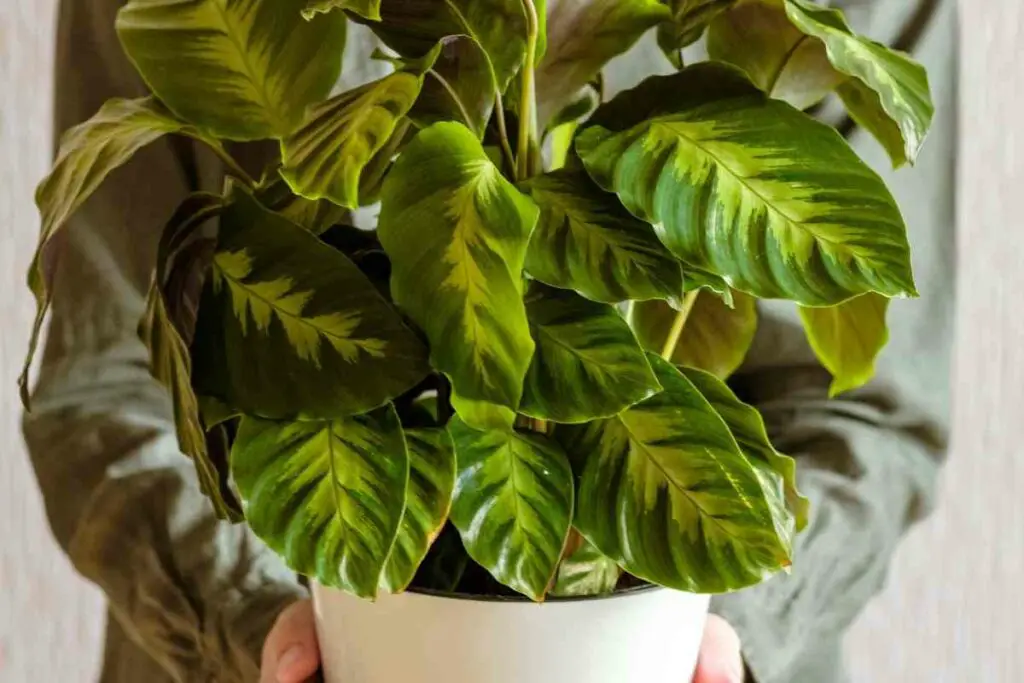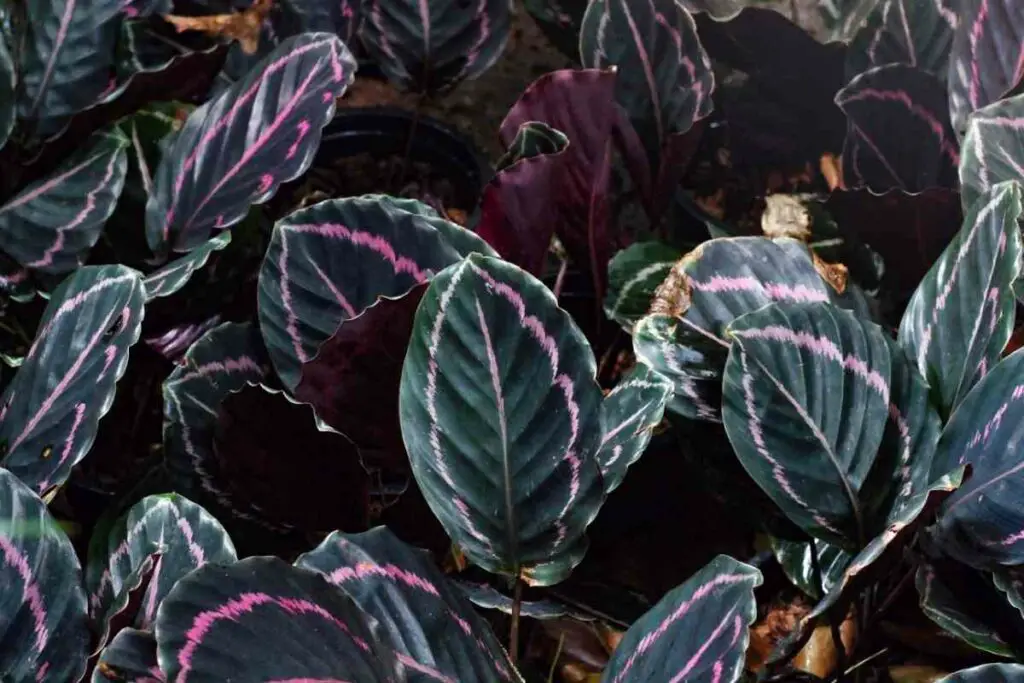Calatheas are tropical indoor plants that are popular in America. Many gardeners have issues with the leaves turning yellow due to inconsistent watering. If you frequently overwater or underwater the plant, the leaves will decay.
Luckily, you just need to make a few changes to stop the leaves from turning yellow; checking the soil before watering is an excellent place to start. You’ll also want to move the plant to a more suitable environment.

Table of Contents
Why Are My Calathea Leaves Changing to Yellow?
Calathea plants are very picky when it comes to their environment.
The leaves can turn yellow just along the edges or all over. If you see yellowing in the middle of the leaf, you need to act quickly to stop it from wilting.
Once you make changes, the plant should sprout new, healthy, green leaves. There are a few reasons why the Calathea leaves can turn yellow, but incorrect watering is the most common problem.
Here’s what you need to change to get healthy leaves again!
You’re Watering It Incorrectly
Calathea leaves turn yellow when watered incorrectly. If you’re under or overwatering the plant, it’s sure to show up in the leaves first. The plant needs to have consistently moist soil. You don’t want to drench it, however!
Always check the soil when you start to notice yellow leaves. Touch the soil with your finger. If the dirt feels dry, water the plant until the drainage holes drip out a steady stream of water.
However, if the soil already feels wet, you won’t want to water it yet.
It’s hard to determine an exact watering schedule with Calathea leaves. It’s best to check the soil with your fingers daily. That way, you’ll know right away when it needs more water.
You’re Not Using the Right Water
Calathea plants are also very picky regarding the type of water they like. You’re also providing the plant with chlorine if you’re using tap water, which can easily harm it.
The minerals and other items in tap water can cause the leaves to be yellow.
Instead of tap water, you’ll want to use distilled water. However, you can also leave out tap water for 24 hours to release the chlorine. Either option works well for this plant.
Water Can’t Drain Well Enough
Additionally, the plant’s container might not have enough drainage. Water can build up in the soil, causing deadly root rot. Changing to a new container can help a lot.
You can also drill more hills in the current container. Water should be able to flow through without pooling in the pot.
It might be time to consider a new container for your Calathea plant. Check out the one below that we’ve found for you.
- Prefers bright, indirect light
- Keep evenly moist, not wet or dry
- Easy to grow house plant
- Proper name: Calathea lancifolia
- Immediate shipping in 4 pot
Prices pulled from the Amazon Product Advertising API on:
Product prices and availability are accurate as of the date/time indicated and are subject to change. Any price and availability information displayed on [relevant Amazon Site(s), as applicable] at the time of purchase will apply to the purchase of this product.
You’re Using Fertilizer
If you’re using fertilizer, you’ll want to ease up on how much you add to the pot.
Adding too much can cause many problems with the plant because Calatheas don’t need much. Many gardeners only offer Calatheas fertilizer once a month.
Make sure you’re only giving the Calathea fertilizer that you’ve diluted significantly. Plus, only give it to the plant during the growing season. Any other time could overwhelm it easily.
Overall, consider how much you’ve been adding to the plant’s soil if you’re using fertilizer. You likely need to use a lot less!

It Doesn’t Have Enough Humidity
Next, the plant might not have enough humidity to thrive. Calatheas need a lot of humidity in the air. Without it, they can turn yellow due to stress.
You want the room with the plant to have 50% to 70% humidity levels. Adding a room humidifier can help you reach those levels. You can also group more Calathea plants for a similar effect.
The Temperature is Off
Plus, the plant is susceptible to temperature changes. You want to keep the plant fairly warm, between 62 and 81 degrees F. If it gets too cold, it will immediately show yellowing.
If you live in a colder area, the plant could be reacting to the temperature changes. They also dislike space heaters, making it hard to keep them healthy during the winter.
In short, check the temperature at home and adjust it to support the plant.
You Don’t Have the Right Lighting Conditions
Calathea plants are extremely sensitive to light. They can turn yellow in both direct and low light, so you need to find a middle ground.
A reliable method is to place the plant near a window with sheer curtains, so it’s not directly in the sun. You can also move the plant out of the direct sun by a few feet for similar results.
The Plant is in a Draft
Think about where you have your Calathea plant. Is it possible in a draft? The temperature change can cause the leaves to turn yellow. Whether it’s hot or cold air, the breeze causes the plant to stress.
Simply moving the Calathea plant to another spot in the room can take it out of the draft. Doing so will help keep your plant healthy.
There’s a Pest Infestation
Calatheas can attract mites and aphids easily. If infested with bugs, their leaves can start to become more yellow.
The spider mites thrive in drive conditions, so make sure that you’re watering the plant often enough.
Misting the plant and washing it thoroughly is an excellent way to deal with mites. Many gardeners also use dish soap to kill spider mites.
Simply mix water and soap in a spray bottle, then mist the plant’s leaves every week. Make sure to get both the tops and the bottoms of the leaves. You’ll need to stay consistent to get rid of the pests.
Should I Cut Off the Yellow Leaves?
Removing the yellow leaves can make the plant look nicer. Find the base of the leaf where it connects to the plant, then cut it with scissors. Removing dead leaves helps the plant focus on growing new ones.
Dead leaves take needed nutrients from the plant. When you remove them, you’ll notice the plant becomes healthier in a few days.
Overall, it’s a good idea to remove yellow and dry leaves from your Calathea plant.
Final Thoughts
Calathea Leaves turning yellow can be caused by many different reasons but most commonly due to either over or under watering the plant.
If your sure its not a watering problem why not check out other solutions above.
- How to Build a Planter Box for Bamboo: A Step-by-Step Guide

- Can Robotic Lawnmowers Handle Steep Slopes?

- Do You Need a Specific Lawn for a Robotic Lawnmower? Expert Advice

- Are Robotic Lawnmowers Safe for Pets and Children? Safety Features of Robotic Lawnmowers

- Why Use Robotic Lawnmowers? Advantages of Using a Robotic Lawnmower

- Is the GARDENA SILENO City 300 Cordless or Corded? A Clear Answer















